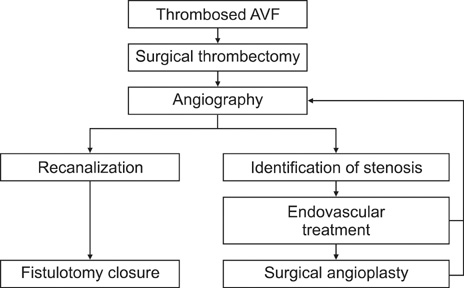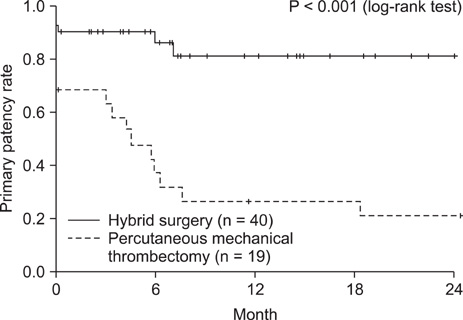J Korean Surg Soc.
2011 Jul;81(1):43-49. 10.4174/jkss.2011.81.1.43.
Hybrid surgery versus percutaneous mechanical thrombectomy for the thrombosed hemodialysis autogenous arteriovenous fistulas
- Affiliations
-
- 1Department of Surgery, Kwandong University College of Medicine Myongji Hospital, Kwandong University College of Medicine, Goyang, Korea. hartsol@kwandong.ac.kr
- 2Department of Radiology, Kwandong University College of Medicine Myongji Hospital, Kwandong University College of Medicine, Goyang, Korea.
- KMID: 1853530
- DOI: http://doi.org/10.4174/jkss.2011.81.1.43
Abstract
- PURPOSE
For the successful treatment of thrombosed autogenous arteriovenous fistula (AVF), we designed and performed a hybrid surgery. Its clinical outcomes were compared with those of percutaneous mechanical thrombectomy, retrospectively.
METHODS
Forty cases of thrombosed autogenous AVFs underwent hybrid surgery, whereas 19 cases received percutaneous mechanical thrombectomy. Hybrid surgery consisted of surgical thrombectomy, balloon angioplasty and/or additional surgical angioplasty. Percutaneous mechanical thrombectomy included catheter-introduced thrombus aspiration, balloon angioplasty and/or stenting. Procedure related outcomes such as technical success rates and primary patency rates were analyzed, retrospectively.
RESULTS
There were no statistically significant differences between the two groups in terms of demographic data of the patients including age, gender, diabetes status, and frequency of antiplatelet use, as well as the characteristics of thrombosed autogenous AVFs such as access age, site, type, and length of time between thrombosis and AVF creation (P > 0.05). Technical success rates (92.5% vs. 68.4%, P = 0.005, respectively) and primary patency rates (85.9% vs. 36.8% at 6 months, 81.1% vs. 26.3% at 12 months, 81.1% vs.21.1% at 18 and 24 months respectively, log-rank test, (P < 0.001) were significantly higher in the hybrid surgery group. In terms of cost analysis, supply cost was not different (P = 0.065), but total cost was statistically lower in the hybrid surgery group (P = 0.019).
CONCLUSION
Hybrid surgery showed better technical success rates and patency rates in the salvaging of thrombosed autogenous AVFs than in percutaneous mechanical thrombectomy.
Keyword
MeSH Terms
Figure
Reference
-
1. Allon M, Robbin ML. Increasing arteriovenous fistulas in hemodialysis patients: problems and solutions. Kidney Int. 2002. 62:1109–1124.2. Vascular Access 2006 Work Group. Clinical practice guidelines for vascular access. Am J Kidney Dis. 2006. 48:Suppl 1. S176–S247.3. Palder SB, Kirkman RL, Whittemore AD, Hakim RM, Lazarus JM, Tilney NL. Vascular access for hemodialysis. Patency rates and results of revision. Ann Surg. 1985. 202:235–239.4. Green LD, Lee DS, Kucey DS. A metaanalysis comparing surgical thrombectomy, mechanical thrombectomy, and pharmacomechanical thrombolysis for thrombosed dialysis grafts. J Vasc Surg. 2002. 36:939–945.5. Dougherty MJ, Calligaro KD, Schindler N, Raviola CA, Ntoso A. Endovascular versus surgical treatment for thrombosed hemodialysis grafts: a prospective, randomized study. J Vasc Surg. 1999. 30:1016–1023.6. Marston WA, Criado E, Jaques PF, Mauro MA, Burnham SJ, Keagy BA. Prospective randomized comparison of surgical versus endovascular management of thrombosed dialysis access grafts. J Vasc Surg. 1997. 26:373–380.7. Shatsky JB, Berns JS, Clark TW, Kwak A, Tuite CM, Shlansky-Goldberg RD, et al. Single-center experience with the Arrow-Trerotola Percutaneous Thrombectomy Device in the management of thrombosed native dialysis fistulas. J Vasc Interv Radiol. 2005. 16:1605–1611.8. Rajan DK, Clark TW, Simons ME, Kachura JR, Sniderman K. Procedural success and patency after percutaneous treatment of thrombosed autogenous arteriovenous dialysis fistulas. J Vasc Interv Radiol. 2002. 13:1211–1218.9. Jain G, Maya ID, Allon M. Outcomes of percutaneous mechanical thrombectomy of arteriovenous fistulas in hemodialysis patients. Semin Dial. 2008. 21:581–583.10. Ponikvar R. Surgical salvage of thrombosed arteriovenous fistulas and grafts. Ther Apher Dial. 2005. 9:245–249.11. Turmel-Rodrigues L. Dilatation and declotting of arteriovenous accesses. Ther Apher Dial. 2003. 7:244–251.12. Palmer RM, Cull DL, Kalbaugh C, Carsten CG, Taylor SM, Snyder BA, et al. Is surgical thrombectomy to salvage failed autogenous arteriovenous fistulae worthwhile? Am Surg. 2006. 72:1231–1233.
- Full Text Links
- Actions
-
Cited
- CITED
-
- Close
- Share
- Similar articles
-
- A Case of Mechanical Thrombolysis of Thrombosed Native Hemodialysis Fistula Using Arrow Trerotola Percutaneous Thrombolytic Device
- Percutaneous Treatment of Thrombosed Native Arteriovenous Dialysis Fistula Insufficiency: Efficacy of Mechanical Thrombectomy with Using the Stone Basket
- Clinical outcome of percutaneous thrombectomy of dialysis access thrombosis by an interventional nephrologist
- Intervention of the Dysfunctional and Thrombosed Autogenous Vascular Access
- The Comparative Analysis between Surgical Thrombectomy and Hybrid Treatment in Salvage Operation



